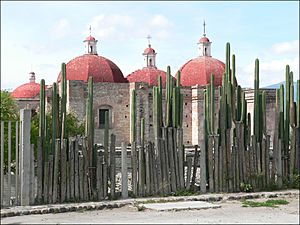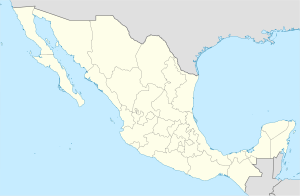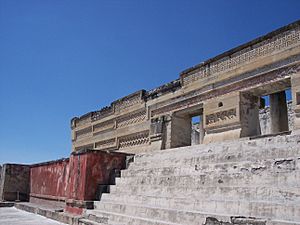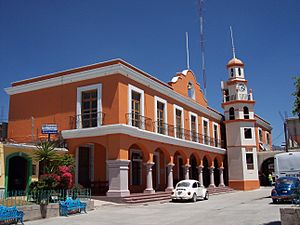San Pablo Villa de Mitla facts for kids
Quick facts for kids
San Pablo Villa de Mitla
Mitla
|
|
|---|---|
|
Town & Municipality
|
|

Church of San Pablo in Mitla
|
|
| Country | |
| State | Oaxaca |
| Area | |
| • Municipality | 82.93 km2 (32.02 sq mi) |
| Elevation
(of seat)
|
1,680 m (5,510 ft) |
| Population
(2005) Municipality
|
|
| • Municipality | 11,219 |
| • Seat | 7,829 |
| Time zone | UTC-6 (Central (US Central)) |
| Website | site |
San Pablo Villa de Mitla is a town and municipality in Mexico. It is well-known for the ancient Mitla archeological ruins. This town is part of the Tlacolula District in the eastern part of the Central Valleys Region.
The town is also famous for its handmade textiles. These include special embroidered items. Another popular product is mezcal, a traditional drink. Mitla also has a museum with many cultural items from the Zapotec and Mixtec cultures.
The name "San Pablo" honors Saint Paul. "Mitla" comes from the Nahuatl word "Mictlán." This was the name the Aztecs gave the old city before the Spanish arrived. It means "land of the dead." The town is located in the Central Valleys of Oaxaca, about 46 km from the city of Oaxaca.
Contents
Exploring the Town of Mitla
The town of Mitla is the main center for business and tourism in the area. Many homes in modern Mitla are around 200 years old. They have a simple, traditional style. In many of these houses, you can find workshops where people weave and embroider. They sell their beautiful creations to visitors.
The town has a cultural center, called a "Casa de Cultura." Here, people can take classes, such as traditional dance.
Handicrafts and Textiles
There is a small outdoor Handcrafts Market right outside the ancient ruins. Most of the items sold here are textiles. These include traditional clothes woven and embroidered by hand. You can also find hammocks, sarapes, rugs, handbags, and tablecloths.
People also make necklaces and bracelets. They braid them from fibers and decorate them with beads, seeds, small stones, or ceramic figures. Many designs on the textiles come from old codices. These are ancient books with drawings based on Zapotec myths. You can also find modern designs inspired by Mexican painters.
Churches of Mitla
The town has two churches. One is for Saint John the Apostle, and the other is for Saint Paul. When the Spanish arrived in the 1520s, the ancient city of Mitla was a very important religious place in the Oaxaca Valley.
In 1544, the Church of San Pablo was built on top of some of the old Zapotec religious complex ruins. The church stands on an ancient platform, which now serves as its courtyard. The entrance to the church has decorations with pyramid shapes. The church is 39 meters long and 12 meters wide. It has three main sections with special octagonal domes.
The wall of the south courtyard was originally part of an ancient building. It still has the unique mosaic fretwork patterns. These patterns are a key feature of the Zapotec site. Inside the church, you can see many old statues of saints, called santos. Many of these are from the 16th century and are still brightly colored.
Celebrating Saint Paul
The town's patron saint, Saint Paul, is celebrated in January. A procession starts at the Church of San Pablo, goes through the town cemetery, and ends in the town center. Traditional drinks are offered to everyone who attends. Most people in the town join the procession. Music groups play, and large, fun figures like giant monkeys are made for the event.
Frissell Museum
On Benito Juarez Street, near the main square, is the Frissell Museum building. It used to be an inn called La Sorpresa in the late 1800s and early 1900s. In the 1950s, an American named Edwin Robert Frissell bought the building. He collected many ancient artifacts and started the museum.
The museum's collection grew with donations from Howard Leigh, who collected Zapotec art. The museum opened in 1950. It was supported by a group called the Junta Cultural Zapoteca de Mitla.
The museum has different rooms that show how Zapotec and Mixtec art changed over time. You can see pottery like urns, jars, and bowls. There are also items made of jade and obsidian. The collection includes many idols, axes, and other pieces. At one point, the museum was known for having the largest collection of Zapotec cultural items.
The museum closed in 1995. For several years, people did not know why. Later, it was found that the museum building had been sold. The museum's entire collection of artifacts disappeared sometime between 1995 and 2007. After a long period, the museum finally reopened in August 2023.
Mitla Archeological Site
The main reason people visit Mitla is to see the ruins of the ancient city. These buildings are famous for their decorations. They have mosaics made of small, flat stones fitted together to create designs, especially fretwork patterns.
The Mitla ruins are the second most visited archeological site in Oaxaca. Most of the town's economy relies on tourism to this site. You will find many restaurants, small hotels, and shops selling handicrafts and traditional drinks. About 500 people visit Mitla every day. Most visitors are from Mexico, especially from nearby states like Puebla and Veracruz. Many foreign visitors come from Europe.
Mitla Municipality
The town of San Pablo Villa de Mitla is the main center for the surrounding communities. These include San José del Paso, San Miguel Albarradas, and Xaagá. The municipality covers an area of 82.93 square kilometers. In 2005, the total population was 11,219 people. About 7,829 people, or 70%, live in the main town. About one-third of the population speaks an indigenous language.
Geography and Nature
Most of the area has rolling hills at the base of the Sierra del Norte mountains. Important hills include Dan Guido, or Hill of the Temple, and Dan Belgo, or Jar Hill. The only large river here is the Grande River. Many small streams flow into it, especially during the rainy season.
The climate is mild and quite dry. The rainy season is from June to September. It often freezes in winter. Higher areas have pine forests. Lower, drier areas have plants like mesquite, maguey, and nopal cactus. The forests are home to small and medium-sized animals. These include wolves, coyotes, deer, wild boar, and foxes. There are also birds and some poisonous snakes.
Economy and Local Products
About 20% of the people in Mitla work in agriculture. The other 80% work in crafts or tourism. Handmade crafts are a major source of income. These include embroidered cloths and woven wool items. People make traditional clothing on hand-operated looms. They also create hammocks, sarapes, rugs, and tablecloths. Many of these items are also embroidered. Jewelry made from natural materials is also available. The municipality also has quarries that produce pink "cantera" stone for building.
Ancient Discoveries
South of the main town is the Hacienda de Xaga. Here, a cross-shaped tomb was found. It is decorated with fretwork and still has its original paint. Another tomb was discovered at a hill called Guirui. Remains of an ancient fort were also found there.
At a nearby hill called La Forteleza, scientists found 21 skeletons. These included men, women, and children, dating back to 500 C.E. Jars, pottery pieces, and a stone carving of a jaguar were also found. Corncobs were also discovered.
Traditional Culture
Traditional music in Mitla is played by bands with wind instruments and marimbas. You can also hear the chirimía, a reed instrument from Hispanic origins.
The local food is based on different kinds of moles, such as black, green, yellow, and red mole. Another popular dish is liver with eggs. Local drinks include hot chocolate made with water, corn atole, and atole with panela cheese or chocolate. Other drinks are "tejate," pozole (a fermented corn and cacao drink), a drink made from a fruit called cilacayota, and tepache.
Mezcal is an important distilled drink here. It is bottled plain or with added flavors. The flavored mezcals are called "cremas" (creams). They come in flavors like orange, coconut, coffee, and lime. In Mitla and nearby towns, there are "palenques." These are small places where mezcal is made by hand from the agave plant. About 5 km from Mitla is a village called Matatlán. Because of its many palenques, it is known as the "mezcal capital of the world."
Day of the Dead Celebrations
Day of the Dead is a very important celebration in Mitla. This area has a history of being connected to rest and the underworld. Ofrendas, or altars, are set up in homes for family members who have passed away.
Celebrations start at midday on October 31. Church bells ring to welcome the spirits of children who have died. On November 1, families visit graves. They clean and decorate tombs and place offerings there. Fireworks are set off to help the spirits find their way back home. From midday on November 1 to midday on November 2, people believe the spirits are among the living. They enjoy the food and drinks left on the altars. This activity is called "togolear," from the Zapotec word "togool," meaning "dead."
On November 3, a costume party is held in Mitla's central park. People in costumes compete for cash prizes for originality. On the night of the 3rd, groups called "krewes" (like those for Carnival) act out traditional events, such as weddings. They dress up as skeletons. On November 4, paintings that have been on display since October 30 are judged and awarded prizes.
Notable People
Restaurateur and author Bricia Lopez was born in San Pablo Villa de Mitla.
Images for kids
See also
 In Spanish: San Pablo Villa de Mitla para niños
In Spanish: San Pablo Villa de Mitla para niños











